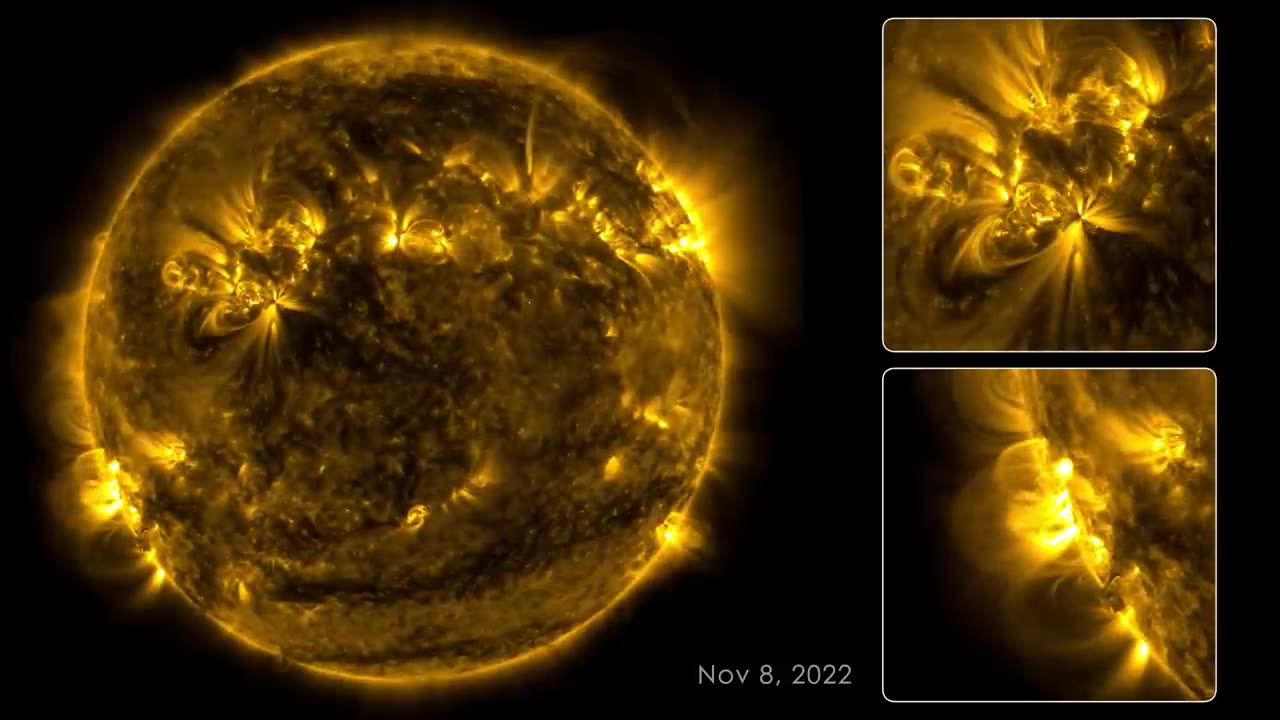Premium Only Content

The Sun
133 days on the SUN.
Characteristics of the sun
The sun resides some 26,000 light-years from the Milky Way's center, in a tendril of our home galaxy known as the Orion Arm. Every 230 million years, the sun—and the solar system it carries with it—makes one orbit around the Milky Way's center. Though we can't feel it, the sun traces its orbit at an average velocity of 450,000 miles an hour.
The sun formed more than 4.5 billion years ago, when a cloud of dust and gas called a nebula collapsed under its own gravity. As it did, the cloud spun and flattened into a disk, with our sun forming at its center. The disk's outskirts later accreted into our solar system, including Earth and the other planets. Scientists have even managed to see these planet-birthing disks around our sun's distant young cousins.
Our home star is a yellow dwarf, a medium-size variety that's fairly common in our galaxy. The label “yellow” is misleading, though, since our sun burns a bright white. On Earth, the sun can take on warmer hues, especially at sunrise or sunset, because our planet's atmosphere scatters blue and green light the most.
From our perspective, “dwarf” might not be the best word for our sun, either. At about 864,000 miles (1.4 million kilometers) wide, the sun is 109 times wider than Earth, and it accounts for more than 99.8 percent of the solar system's total mass. If it was a hollow ball, more than a million Earths could fit inside it. But the sun isn't hollow: It's filled with scorching gases and soups of electrically charged particles called plasma. The sun's surface temperature is about 10,000 degrees Fahrenheit (5,500 degrees Celsius), and it's 27 million degrees Fahrenheit (15.5 million Celsius) at the core.
Deep in the sun's core, nuclear fusion converts hydrogen to helium, which generates energy. Particles of light called photons carry this energy through a spherical shell called the radiative zone to the top layer of the solar interior, the convection zone. There, hot plasmas rise and fall like the ooze in a lava lamp, which transfers energy to the sun's surface, called the photosphere.
It can take 170,000 years for a photon to complete its journey out of the sun, but once it exits, it zips through space at more than 186,000 miles a second. Solar photons reach Earth about eight minutes after they're freed from the sun's interior, crossing an average of 93 million miles to get here—a distance defined as one astronomical unit (AU).
Out beyond the sun's photosphere lies the atmosphere, which consists of the chromosphere and the solar corona. The chromosphere looks like a reddish glow fringing the sun, while the corona's huge white tendrils extend millions of miles long. The chromosphere and corona also emit visible light, but on Earth's surface, they can be seen only during a total solar eclipse, when the moon passes between Earth and the sun.
#Sun
#NASA
#NASAMission
#SolarSystem
Follow 👇
https://rumble.com/user/Kami64
-
 8:52
8:52
Tundra Tactical
3 hours ago $1.61 earnedSCOTUS Denies Appeal, Minnesota Courts Deal 2a Win!
2.81K7 -
 22:27
22:27
Exploring With Nug
11 hours ago $6.86 earnedSwamp Yields a Chilling Discovery in 40-Year Search for Missing Man!
15.8K10 -
 1:23:26
1:23:26
RiftTV/Slightly Offensive
6 hours ago $7.03 earnedThe LUCRATIVE Side of Programming and the SECRETS of the "Tech Right" | Guest: Hunter Isaacson
31.3K15 -
 LIVE
LIVE
a12cat34dog
4 hours agoONE WITH THE DARK & SHADOWS :: The Elder Scrolls IV: Oblivion Remastered :: FIRST-TIME PLAYING {18+}
201 watching -
 27:57
27:57
MYLUNCHBREAK CHANNEL PAGE
23 hours agoDams Destroyed India
43.3K18 -
 LIVE
LIVE
Phyxicx
7 hours agoLast minute practice before Sunday - 4/26/2025
226 watching -
 LIVE
LIVE
The Official Steve Harvey
10 days ago $4.12 earned24 HOURS OF MOTIVATION w/ STEVE HARVEY
76 watching -
![Nintendo Switch It UP Saturdays with The Fellas: LIVE - Episode #16 [Clue]](https://1a-1791.com/video/fww1/eb/s8/1/L/3/n/F/L3nFy.0kob-small-Nintendo-Switch-It-UP-Satur.jpg) LIVE
LIVE
MoFio23!
12 hours agoNintendo Switch It UP Saturdays with The Fellas: LIVE - Episode #16 [Clue]
115 watching -
 LIVE
LIVE
StaleSavage
3 hours ago"MASTER PRACTICE"
47 watching -
 39:29
39:29
Stephen Gardner
6 hours ago🔥Pam Bondi drops NIGHTMARE NEWS on 3 top DEMOCRATS!
57.4K106